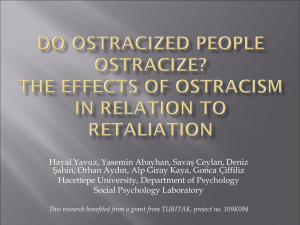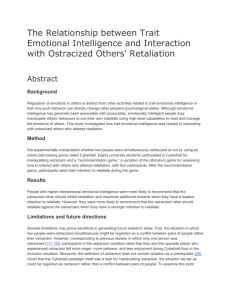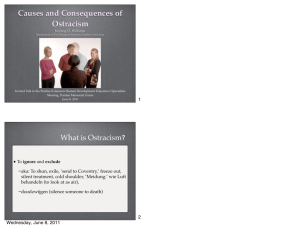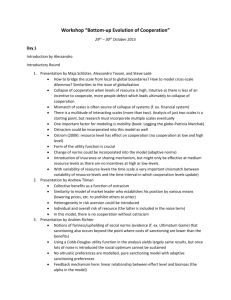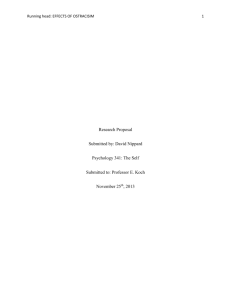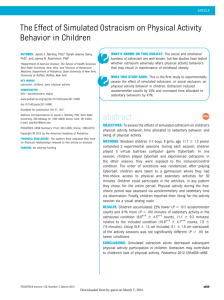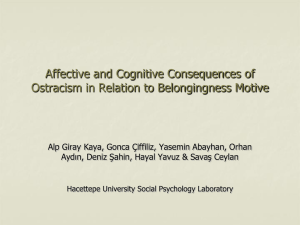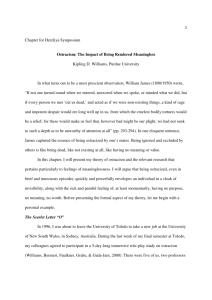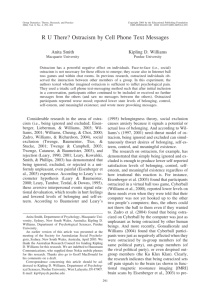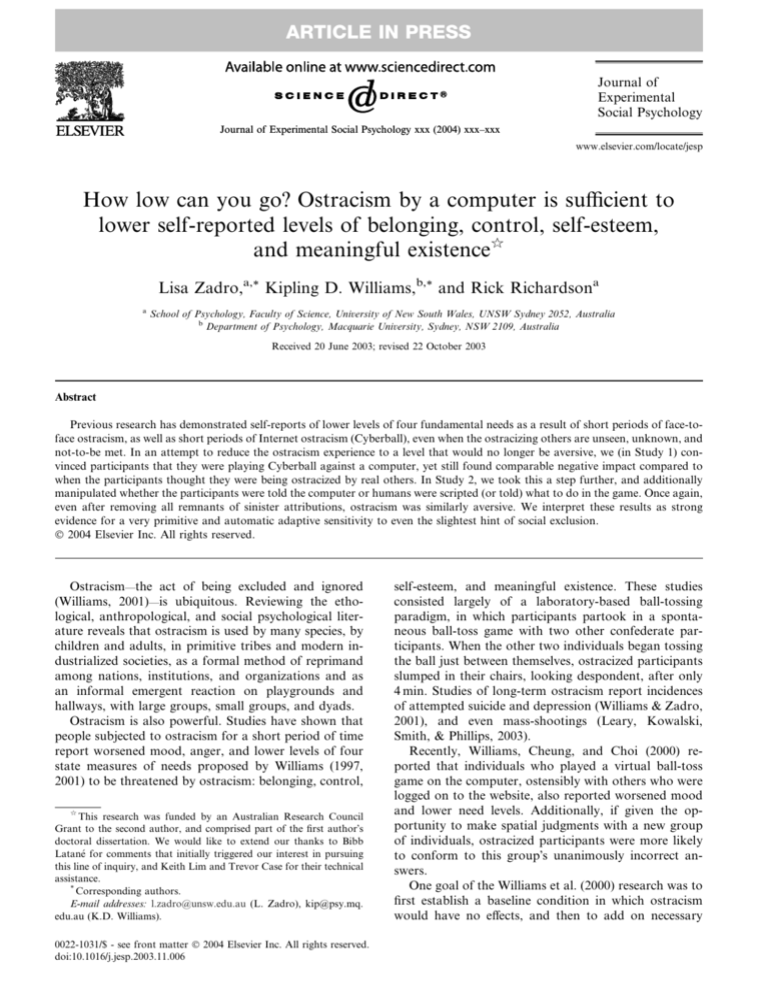
ARTICLE IN PRESS
Journal of
Experimental
Social Psychology
Journal of Experimental Social Psychology xxx (2004) xxx–xxx
www.elsevier.com/locate/jesp
How low can you go? Ostracism by a computer is sufficient to
lower self-reported levels of belonging, control, self-esteem,
and meaningful existenceq
Lisa Zadro,a,* Kipling D. Williams,b,* and Rick Richardsona
a
School of Psychology, Faculty of Science, University of New South Wales, UNSW Sydney 2052, Australia
b
Department of Psychology, Macquarie University, Sydney, NSW 2109, Australia
Received 20 June 2003; revised 22 October 2003
Abstract
Previous research has demonstrated self-reports of lower levels of four fundamental needs as a result of short periods of face-toface ostracism, as well as short periods of Internet ostracism (Cyberball), even when the ostracizing others are unseen, unknown, and
not-to-be met. In an attempt to reduce the ostracism experience to a level that would no longer be aversive, we (in Study 1) convinced participants that they were playing Cyberball against a computer, yet still found comparable negative impact compared to
when the participants thought they were being ostracized by real others. In Study 2, we took this a step further, and additionally
manipulated whether the participants were told the computer or humans were scripted (or told) what to do in the game. Once again,
even after removing all remnants of sinister attributions, ostracism was similarly aversive. We interpret these results as strong
evidence for a very primitive and automatic adaptive sensitivity to even the slightest hint of social exclusion.
Ó 2004 Elsevier Inc. All rights reserved.
Ostracism—the act of being excluded and ignored
(Williams, 2001)—is ubiquitous. Reviewing the ethological, anthropological, and social psychological literature reveals that ostracism is used by many species, by
children and adults, in primitive tribes and modern industrialized societies, as a formal method of reprimand
among nations, institutions, and organizations and as
an informal emergent reaction on playgrounds and
hallways, with large groups, small groups, and dyads.
Ostracism is also powerful. Studies have shown that
people subjected to ostracism for a short period of time
report worsened mood, anger, and lower levels of four
state measures of needs proposed by Williams (1997,
2001) to be threatened by ostracism: belonging, control,
q
This research was funded by an Australian Research Council
Grant to the second author, and comprised part of the first authorÕs
doctoral dissertation. We would like to extend our thanks to Bibb
Latane for comments that initially triggered our interest in pursuing
this line of inquiry, and Keith Lim and Trevor Case for their technical
assistance.
*
Corresponding authors.
E-mail addresses: l.zadro@unsw.edu.au (L. Zadro), kip@psy.mq.
edu.au (K.D. Williams).
0022-1031/$ - see front matter Ó 2004 Elsevier Inc. All rights reserved.
doi:10.1016/j.jesp.2003.11.006
self-esteem, and meaningful existence. These studies
consisted largely of a laboratory-based ball-tossing
paradigm, in which participants partook in a spontaneous ball-toss game with two other confederate participants. When the other two individuals began tossing
the ball just between themselves, ostracized participants
slumped in their chairs, looking despondent, after only
4 min. Studies of long-term ostracism report incidences
of attempted suicide and depression (Williams & Zadro,
2001), and even mass-shootings (Leary, Kowalski,
Smith, & Phillips, 2003).
Recently, Williams, Cheung, and Choi (2000) reported that individuals who played a virtual ball-toss
game on the computer, ostensibly with others who were
logged on to the website, also reported worsened mood
and lower need levels. Additionally, if given the opportunity to make spatial judgments with a new group
of individuals, ostracized participants were more likely
to conform to this groupÕs unanimously incorrect answers.
One goal of the Williams et al. (2000) research was to
first establish a baseline condition in which ostracism
would have no effects, and then to add on necessary
ARTICLE IN PRESS
2
L. Zadro et al. / Journal of Experimental Social Psychology xxx (2004) xxx–xxx
factors until ostracism had a negative impact on the four
needs. The authors were surprised to find out that what
they thought would be the baseline turned out to be
sufficiently adverse. One goal of the present studies,
therefore, was to create conditions even less meaningful
than those in the Williams et al. (2000) studies, in order
to determine the necessary and sufficient conditions for
ostracism to have an aversive impact. To the extent that
such a baseline can be established, then we can gain a
clearer idea what aspects of ostracism are essential.
Study 1
In Study 1, participants were either ignored or included during Cyberball—a cyber analogue of a balltossing game (Williams et al., 2000, 2002)—by two
other players whose identity was manipulated. Targets
were told that they were playing Cyberball with either
two computer-generated players or two human players
prior to the start of the game. If the identity of the
source is an important component in determining the
aversiveness of ostracism, then targets who are ostracized by two human players should report lower levels
of primary needs than targets who are ostracized by
two computer-generated players or targets who are
included in the game. If the identity of the source is not
important—rather, the very act of ostracism is aversive
enough to induce deleterious psychological effects—
then targets who are ostracized by humans or computers should both report lower levels of mood and of
the four primary needs when compared to targets who
are included in the game.
Method
Participants and design
Eighty first-year undergraduates enrolled in introductory psychology at the University of New South
Wales were randomly assigned to a 2 (inclusionary status: ostracism vs. inclusion) 2 (attributed source:
computer-generated players or human players) betweenS design. Participants volunteered to take part in the
experiment in return for course credit. Eighteen participants were excluded because of technical difficulties
with the computers and the Internet connection, thus
the final experiment consisted of 62 participants (20
males, 42 female, M age ¼ 19.9, SD ¼ 2:7).
Procedure
One participant per session arrived at the laboratory,
and was seated in front of a computer.1 Participants
were told that the study involved the effects of mental
1
In both studies, cardiovascular measures were taken periodically,
but only the self-report data are reported in the present paper.
visualization, and that to assist them in practicing their
skills at mental visualization they would be playing an
Internet ball-toss game on the computer. They were told
that performance in the game was unimportant, and
instead, the game was merely a means for them to engage their mental visualization skills. They were asked to
visualize the situation, themselves, and the other players.
The game was accessed via the Internet (a downloadable
version of this game is available at: http://www.psy.mq.edu.au/staff/kip/Announce/cyberball). The game depicts three ball-tossers, the middle one representing the
participant. The game is animated and shows the icon
throwing a ball to one of the other two. When the ball
was tossed to the participants, they were instructed to
click on one of the other two icons to indicate their intended recipient, and the ball would move toward that
icon. The game was set for 40 total throws (the game
lasted approximately 6 min). Once the instructions were
read, the participant clicked the ‘‘Next’’ link and the
program randomly assigned them to one of the four
conditions. At the end of the game, the website instructed participants to inform the experimenter that
they had finished, and they were then instructed to fill
out a post-experiment questionnaire.
Inclusion/ostracism manipulation. If assigned to the
inclusion condition, participants received the ball for
roughly one-third of the total throws. If assigned to the
ostracism condition, participants received the ball twice
at the beginning of the game, and for the remaining
time, never received the ball again.
Sources manipulation. Half the participants were told
that they were playing with two other individuals who
were stationed in similar laboratories at two other universities in Sydney. This cover story was augmented by
staged phone calls to the other experimenters making
sure that their participants were ready to go. The other
half were told that they were playing the game with a
computer.
Dependent measures. The questionnaire contained
several manipulation checks for inclusion/ostracism:
‘‘What percent of the throws were thrown to you?,’’ ‘‘To
what extent were you included by the other participants
during the game?,’’ and a 9-point bipolar scale (‘‘accepted/rejected’’). The questionnaire also contained a
number of questions that asked participants to assess
their levels of four needs that they felt during the game.
These needs were: belonging (‘‘I felt poorly accepted by
the other participants,’’ ‘‘I felt as though I had made a
‘‘connection’’ or bonded with one or more of the participants during the Cyberball game,’’ ‘‘I felt like an
outsider during the Cyberball game’’), control (‘‘I felt
that I was able to throw the ball as often as I wanted
during the game,’’ ‘‘I felt somewhat frustrated during
the Cyberball game,’’ ‘‘I felt in control during the Cyberball game’’), self-esteem (‘‘During the Cyberball
game, I felt good about myself,’’ ‘‘I felt that the other
ARTICLE IN PRESS
L. Zadro et al. / Journal of Experimental Social Psychology xxx (2004) xxx–xxx
3
Table 1
Means and standard deviations (in parentheses) of variables in Study 1 (all scales 1 ¼ not at all to 9 ¼ very much so, unless otherwise stated)
Source
Human
Fundamental needsa
Belonging (a ¼ :74)
F ð1; 57Þ ¼ 34:99, p < :0005b
Control (a ¼ :72)
F ð1; 57Þ ¼ 32:5, p < :0005
Self-esteem (a ¼ :70)
F ð1; 57Þ ¼ 11:1, p ¼ :002
Meaningful existence (a ¼ :66)
F ð1; 58Þ ¼ 50:7, p < :0005
Moodc
Ancillary variables
I enjoyed playing the Cyberball game
F ð1; 58Þ ¼ 10:2, p ¼ :002
I felt angry during the Cyberball game
F ð1; 58Þ ¼ 8:2, p ¼ :006
Manipulation checks
To what extent were you included by the participants during the game?
F ð1; 58Þ ¼ 67:3, p < :0005
What percentage of throws do you think your received during the
Cyberball game?
F ð1; 58Þ ¼ 83:9, p < :0005
Rejected–acceptedd
F ð1; 57Þ ¼ 24:3, p < :0005
Computer
Inclusion
ðn ¼ 18Þ
Ostracism
ðn ¼ 15Þ
Inclusion
ðn ¼ 17Þ
Ostracism
ðn ¼ 12Þ
6.4 (1.5)
3.4 (2.1)
6.5 (1.7)
3.7 (2.3)
6.4 (1.7)
3.2 (1.6)
5.8 (1.7)
3.8 (1.9)
7.1 (1.2)
5.6 (2.1)
6.9 (1.1)
5.5 (2.1)
6.8 (1.4)
3.8 (1.8)
6.5 (1.5)
3.7 (1.7)
6.5 (1.2)
6.4 (1.4)
6.5 (1.1)
6.5 (1.2)
4.9 (2.4)
2.8 (2.0)
4.5 (2.2)
2.9 (2.5)
1.8 (1.6)
2.1 (1.5)
1.2 (.39)
3.3 (2.5)
7.1 (1.6)
2.7 (2.0)
6.1 (1.8)
2.8 (2.1)
37.1 (13.9)
8.3 (4.8)
40.1 (17.8)
9.3 (7.5)
6.8 (1.5)
4.0 (2.1)
6.2 (1.9)
4.2 (2.2)
a
Each fundamental need score represents an average of three questions.
All F values refer to significant ostracism vs. inclusion main effects.
c
Total mood score was an average of four 9-point bipolar questions.
d
This was a 9-point scale with rejected–accepted as anchors.
b
participants failed to perceive me as a worthy and likeable person,’’ ‘‘I felt somewhat inadequate during the
Cyberball game’’), and meaningful existence (‘‘I felt that
my performance [e.g., catching the ball, deciding whom
to throw the ball to] had some effect on the direction of
the game,’’ ‘‘I felt non-existent during the Cyberball
game,’’ ‘‘I felt as though my existence was meaningless
during the Cyberball game’’). Mood was assessed using
four bipolar questions (bad/good, happy/sad, tense/relaxed, and aroused/not aroused). The questionnaire also
contained two ancillary variables (‘‘I felt angry during
the Cyberball game’’ and ‘‘I enjoyed playing the Cyberball game’’). Unless otherwise stated, all questions
were rated on 9-point scales (where 1 ¼ not at all, and
9 ¼ very much so).
After the participants indicated that they had finished
the questionnaire, the experimenter asked participants
about their thoughts/feelings during the study, and
performed a verbal manipulation check by asking participants whether they had played the game with university students or computer players. They were then
thoroughly debriefed about the aims of the study,
thanked, and given course credit for participating in the
study.
Results
Manipulation checks. There were three manipulation
checks assessing inclusionary status. As shown in Table
1, participants in the ostracism condition reported that
they felt significantly less included and more rejected
than participants in the inclusion condition (smallest F
was for rejection, F ð1; 57Þ ¼ 24:3, p < :0001). Participants in the ostracism condition also reported that they
received the ball less often during the game than participants in the inclusion condition, F ð1; 58Þ ¼ 83:9,
p < :0001.2 This suggests that participants correctly
perceived whether they were included or ostracized
during the game.
To assess the source manipulation, a verbal manipulation check was carried out at the end of the study
prior to debriefing. All but two participants correctly
identified whether they played the game with computer
or human players. The two aberrant participants (both
in the human players condition) reported having played
the game with two computers rather than two humans.
2
Degrees of freedom vary slightly in the analyses here and in Study
2 because of occasional missing data.
ARTICLE IN PRESS
4
L. Zadro et al. / Journal of Experimental Social Psychology xxx (2004) xxx–xxx
The game had malfunctioned during their participation
(a factor that may have led them to realize that they
could not have been playing with two humans). Consequently, their self-report data were not included in the
analysis.
Self-reported levels of needs. The items assessing the
four needs (state measures of belonging, control, selfesteem, and meaningful existence) were reverse scored
where necessary and the internal consistency of the items
assessing each need were examined. CronbachÕs alpha
coefficients for each need were: belonging ¼ 74; control ¼ 72; self-esteem ¼ 70; and meaningful existence ¼ 66. The coefficients suggested a reasonable level
of internal consistency for each need; thus the average
for the items assessing each need were used in the
analysis.
The main findings of this study, that ostracized participants reported lower levels of the needs independent
of the source, can be seen in Fig. 1 (which depicts a
composite score for the four conditions tested in this
study). Statistical analysis of each need (see Table 1 for
all descriptive statistics) revealed that ostracized participants reported lower levels on each of the four needs
measured, smallest F ð1; 57Þ ¼ 11:1, p ¼ :002, for selfesteem. There were no significant main effects for source
identity on self-reported needs, nor did the inclusionary
status interact with the source manipulation, all
F s < 1:4, ns.
Mood. The mood items were reverse scored where
necessary (so that a higher score ¼ more positive mood)
and an average mood score was calculated. There were
no significant main effects or interactions for mood, all
F s < 1:0, ns.
Ancillary variables. Ostracized participants reported
feeling angrier than included participants (see Table 1),
Fig. 1. Mean self-reported levels of combined needs of belonging,
control, self-esteem, and meaningful existence, as a function of inclusion or ostracism, and by either human or computer in Study 1.
F ð1; 58Þ ¼ 8:2, p ¼ :006. There was no main effect for
whether they played with humans or computers, but
there was a significant interaction, F ð1; 58Þ ¼ 4:7,
p ¼ :034, such that anger was higher only when they
were ostracized by the computer.
Ostracized participants reported enjoying the game
less compared with included participants, F ð1; 58Þ ¼
10:2, p ¼ :002. There was no significant main effect of
source identity, or interaction between inclusionary
status and source identity, for enjoyment of the game,
both F s < 1, ns.
Discussion
In Study 1, we found that compared to included
participants, ostracized participants reported lower levels on the state measures of the four needs. Moreover,
ostracized participants also reported feeling angrier and
enjoyed the game less than included participants. Contrary to our expectations, mood reports were not affected by ostracism. It should be noted, however, that
the literature to date is surprisingly inconsistent on the
effects of social exclusion on mood. That is, while some
have reported worsened mood following ostracism
(Williams, 2001) or rejection (Leary, Koch, & Hechenbleiker, 2001), others have failed to see an effect on
mood following social exclusion (Twenge, Baumeister,
Tice, & Stucke, 2001; Twenge, Catanese, & Baumeister,
2002).
Although the ostracism manipulation adversely affected participants in accordance with previous ostracism research, whether participants were ostracized by
humans or the computer had no effect on their self-reported need levels, or enjoyment of the game. Oddly
enough, the only impact that the human/computer manipulation had was the unexpected interaction showing
that being ostracized by a computer made participants
angrier than being ostracized by humans. Based on
comments made during the interviews it would seem
that this result was due to a violation of the basic assumption that the computer is a tool to serve humans
and hence should not deliberately act to distress or
alienate them. For example, one participant (who happened to be a computer programmer) stated that he felt
incredibly angry and frustrated during the game because
‘‘the computer is supposed to serve me. ItÕs not supposed
to reject me.’’
Why would individuals report lower levels of belonging, control, self-esteem, and meaningful existence
when they have experienced ostracism in a 6-min game
of virtual ball toss, regardless of whether they were
playing with humans or a computer? We believe that
initial reactions to ostracism are, in BrewerÕs (2003)
terms, ‘‘deep,’’ rather than ‘‘high.’’ That is, it is our
position that ostracism has such adaptive significance
for humans that there is essentially an early warning
ARTICLE IN PRESS
L. Zadro et al. / Journal of Experimental Social Psychology xxx (2004) xxx–xxx
system that is quick to perceive social exclusion and feel
the associated pain, so that the individual is motivated
to make changes that will eliminate the ostracism.
One potential problem with Study 1 is that participants were not asked to indicate on the post-experimental questionnaire whether they believed they were
playing the game with humans or computers. Although
we assessed their perceptions in a post-experimental
interview, it is possible that experimenter bias may have
influenced our perceptions of their answers. Thus, although we think this is rather implausible, it is possible
that participants simply did not attend to our instruction about who they were playing the ball game with,
and that is why we found no main effects or interactions
with the human/computer manipulation on the self-reported needs. That we found one interaction on the
measure of anger (in an unexpected direction, we might
add), argues against this criticism that participants were
not attentive to the human/computer manipulation;
however, it is possible that this interaction was spurious.
Therefore, in Study 2, we added explicit manipulation
checks to the post-experimental questionnaire assessing
the participantsÕ understanding of with whom they were
playing. In Study 2, we also extended the present experimental design by adding a third factor: perceived
choice of the source. It may well be that to feel threats to
the four needs an individual must attribute some sort of
sinister intent on the part of the sources (Kramer, 1994).
What if we told them that the players with whom they
were playing were following a script that had been
provided to them, and that they had no choice but to
throw the ball to the individual that the script indicated?
If the needs that are threatened by ostracism require
some higher level interpretation of the ostracism event,
then we would expect this manipulation to eliminate the
negative impact when participants viewed the ostracism
behavior of the sources as outside their control. If,
however, the fundamental needs are affected without
cognitive intervention, then manipulations aimed at reducing sinister attributions may have no impact at all.
Study 2
In Study 2, we examined whether providing an explicit and external reason for ostracism reduced its
negative impact. If ostracized individuals know that the
reason they are not being thrown the ball has nothing to
do with them personally, but rather the other participants (be they human or computer) are simply following
a script, will they still report reduced levels of the four
needs? If so, we believe this suggests that it is the perception of oneÕs own ostracism, not oneÕs understanding
of it, that is immediately threatening.
Thus, participants in Study 2 were either included or
ostracized from the Cyberball game by two human
5
players or two computer-generated players. In addition,
half of the participants were informed that the players
(whether human or computers) were playing Cyberball
according to a script given to them by the experimenter.
This script instructed the players to whom they were to
throw the ball every time it was their turn to play.
Study 2 also included self-report manipulation
checks to supplement the verbal manipulation checks
used in Study 1, and some additional questions were
asked to assess other aspects of the Cyberball
experience.
Method
Participants and design
Seventy-seven undergraduates (30 males, 41 female,
M age ¼ 19:6 years, SD ¼ 1:9) enrolled in introductory
psychology at the University of New South Wales were
randomly assigned to a 2 (inclusionary status: inclusion
vs. ostracism) 2 (source identity: computer generated
vs. university students) 2 (attribution of choice:
scripted vs. unscripted) between-S design.3 Participants
volunteered to take part in the experiment in exchange
for course credit.
Procedure
The experiment was conducted on eight versions (one
per condition) of an Internet website, which were identical to those used in Study 1 except for modifications to
the cover pages to accommodate the attribution of
choice manipulation. The ostracism/inclusion and
source identity manipulations were identical to those
used in Study 1.
Attribution of choice manipulation. In the scripted
conditions, the cover page instructed participants that
the other players (whether computer generated or human) would be playing the game according to a script,
and hence their actions were not spontaneous. In the
unscripted condition, participants were instructed that
the game was spontaneous and the players were free to
throw the ball to whomever they chose (in the case of the
computer-generated players, this spontaneous action
was explained by saying that the players would be
throwing the ball randomly). In all conditions, participants were reminded that they were free to throw the
ball to whomever they chose.
Dependent measures. The questionnaire was essentially the same as that used in Study 1, with the addition
of manipulation check for source identity (‘‘Did you
play the Cyberball game with: two students from Macquarie and Sydney University or two computer-generated players?’’) and attribution of choice (‘‘Was the
sequence of throws by Player 1 and Player 2 scripted/
3
Initially, 120 participants were recruited, but a computer virus
prevented 43 participants from any form of participation.
ARTICLE IN PRESS
6
L. Zadro et al. / Journal of Experimental Social Psychology xxx (2004) xxx–xxx
Results
pre-programmed or spontaneous?’’). One additional
question was added to examine whether the manipulations led participants to feel emotionally hurt (‘‘My
feelings were hurt during the game’’).
After the participants completed the game, they were
directed to complete the post-study questionnaire.
Debriefing. As in the previous experiment, the experimenter asked participants to state whether they had
played the game with two human players or two computers, and whether or not the game had been scripted
or unscripted. The experimenter then fully debriefed
participants, ensuring that they were aware that they
were randomly assigned to conditions. Participants in
the ostracism condition were carefully debriefed about
all aspects of the game, and were given extra information about the nature of ostracism. After answering any
remaining questions, participants were then thanked
and dismissed.
Manipulation checks. As shown in Table 2 (where
means and standard deviations can be found for all
dependent variables), our manipulations were perceived
as intended. Participants in the ostracism condition reported that they felt less included than participants in
the inclusion condition, and more rejected, (smallest F
was for rejection, F ð1; 69Þ ¼ 25:6, p < :0005). They also
reported receiving the ball less often during the game
than included participants, F ð1; 66Þ ¼ 117:8, p < :0001
The source identity manipulation was also successful in
that only 2% of participants incorrectly identified the
identity of the players, and 4% of participants incorrectly identified the attribution of choice manipulation.
Because there was no computer malfunction that could
easily account for these incorrect reports, all participants were retained in the analyses.
Table 2
Means and standard deviations (in parenthesis) of variables in Study 2 (all scales 1 ¼ not at all to 9 ¼ very much so, unless otherwise stated)
Source
Human
Computer
Inclusion
Fundamental needsa
Belonging
F ð1; 69Þ ¼ 74:8, p < :0005b
Control
F ð1; 69Þ ¼ 55:0, p < :0005
Self-esteem
F ð1; 69Þ ¼ 25:2, p < :0005
Meaningful existence
F ð1; 69Þ ¼ 68:0, p < :0005
Moodc
F ð1; 69Þ ¼ 6:2, p ¼ :015
Ancillary variables
I felt angry during the Cyberball game
F ð1; 69Þ ¼ 13:2, p ¼ :001
I enjoyed playing the Cyberball game
F ð1; 69Þ ¼ 22:2, p < :0005
My feelings were hurt during the
Cyberball game
F ð1; 69Þ ¼ 8:3, p ¼ :005
Manipulation checks
To what extent were you included
by the participants during the game?
F ð1; 69Þ ¼ 122:7, p < :0005
What percentage of throws did you
receive during the Cyberball game?
F ð1; 69Þ ¼ 117:8, p < :0005
Rejected–acceptedd
F ð1; 69Þ ¼ 25:6, p < :0005
a
Ostracism
Ostracism
Scripted
ðn ¼ 12Þ
Unscripted Scripted
ðn ¼ 8Þ
ðn ¼ 7Þ
Unscripted Scripted
ðn ¼ 11Þ
ðn ¼ 9Þ
Unscripted Scripted
ðn ¼ 10Þ
ðn ¼ 9Þ
Unscripted
ðn ¼ 11Þ
5.8 (1.5)
6.3 (2.0)
3.6 (1.9)
2.8 (1.2)
5.8 (1.6)
6.4 (1.4)
3.0 (1.4)
2.7 (1.3)
5.8 (1.6)
6.8 (2.2)
2.7 (.90)
3.2 (1.5)
4.7 (.98)
5.5 (2.3)
2.9 (.96)
3.2 (1.6)
6.9 (1.0)
7.6 (1.3)
6.1 (1.7)
5.1 (1.9)
6.3 (2.1)
7.7 (1.6)
4.5 (1.7)
5.4 (1.4)
6.1 (1.6)
7.6 (1.1)
2.8 (1.4)
3.6 (2.1)
5.7 (1.4)
6.2 (1.3)
3.7 (1.8)
3.7 (1.3)
6.8 (1.4)
6.7 (1.4)
6.1 (1.3)
6.0 (1.3)
7.0 (.80)
6.6 (1.8)
5.4 (1.7)
6.4 (.88)
1.8 (1.8)
2.0 (2.1)
2.1 (1.4)
2.8 (1.8)
2.2 (1.5)
1.0 (.00)
4.0 (2.2)
4.0 (2.2)
4.6 (2.3)
6.6 (1.8)
3.3 (1.5)
3.0 (1.7)
5.1 (1.8)
5.2 (2.2)
3.3 (2.2)
3.5 (1.8)
2.2 (2.4)
1.1 (.35)
1.1 (.38)
3.2 (2.2)
2.1 (1.8)
1.2 (.42)
4.3 (2.7)
3.0 (2.2)
6.2 (1.5)
6.9 (2.0)
2.4 (.53)
2.6 (1.5)
5.3 (1.7)
6.0 (1.9)
2.2 (.44)
2.6 (.69)
35.9 (14.2) 45.3 (15.0) 11.7 (8.5)
13.9 (8.2)
43.9 (7.7)
45.8 (13.9) 15.7 (9.1)
13.1 (4.6)
6.3 (1.8)
4.2 (2.0)
6.3 (1.9)
5.7 (2.6)
3.5 (1.9)
6.9 (2.2)
4.4 (2.1)
Each fundamental need score represents an average of three questions.
All F values refer to significant ostracism vs. inclusion main effects.
c
Total mood score was an average of four 9-point bipolar questions.
d
This was a 9-point scale with rejected–accepted as anchors.
b
Inclusion
3.4 (2.1)
ARTICLE IN PRESS
L. Zadro et al. / Journal of Experimental Social Psychology xxx (2004) xxx–xxx
Self-reported level of needs. As in Study 1, the items
assessing each need were reverse scored where necessary
and the internal consistency of the items were assessed.
CronbachÕs alpha coefficients for each need were as
follows: belonging ¼ .71; control ¼ .80; self-esteem ¼ .76;
and meaningful existence ¼ .69. The coefficients suggested a reasonable level of internal consistency for each
need; thus the average for the items assessing each need
were used in the analysis.
As in the previous study, there were significant main
effects for inclusionary status on the four needs such that
participants who were ostracized reported lower levels
of belonging, control, self-esteem, and meaningful existence than participants who were included in the game,
(smallest F was for self-esteem, F ð1; 69Þ ¼ 25:2,
p < :0005).
There were no significant main effects for source
identity on the primary needs (largest F was for control,
F ð1; 69Þ ¼ 2:2, p ¼ :147).
Attribution of choice did not affect self-reported need
levels for belonging, control, or self-esteem, but there
was a marginally significant main effect for meaningful
existence, such that participants who believed the game
was unscripted (free choice) reported higher levels of
meaningful existence than participants who believed the
players were scripted, F ð1; 69Þ ¼ 3:9, p ¼ :052.
There was also a marginally significant interaction
between inclusionary status and source identity for
meaningful existence, F ð1; 69Þ ¼ 3:95, p ¼ :051. Follow
up analyses revealed that the effects of inclusion and ostracism on self-reported meaningful existence produced
more extreme differences when the sources were human
than when the sources were computers. No other two-way
interactions for the remaining needs were significant, nor
were there any significant three-way interactions.
Mood. The mood items were reverse scored where
necessary (so that a higher score equalled more positive
mood) and an average mood score was calculated.
Participants in the ostracism condition reported feeling
more negative during the game than participants in the
inclusion condition, F ð1; 69Þ ¼ 6:2, p ¼ :015. There were
no significant main effects for source identity or attribution of choice, nor were there any significant two or
three way interactions, all Fs < 1:5, ns.
Ancillary variables. There were several effects of inclusionary status on the ancillary variables. Specifically,
participants who were ostracized reported feeling angrier, more hurt, and that they enjoyed the game less
than participants who were included in the game,
(smallest F was for anger, F ð1; 69Þ ¼ 8:3, p ¼ :005).
There were no significant main effects for source
identity or attribution of choice on the ancillary variables.
There was a significant two-way interaction between
inclusionary status and source identity for anger,
F ð1; 69Þ ¼ 5:0, p ¼ :028. Follow up analyses revealed
that participants who were included were no more angry
7
if playing a computer or humans, but as in Study 1,
ostracized participants were angrier at being ostracized
by a computer than humans, F ð1; 34Þ ¼ 5:4, p ¼ :026.
No other two-way interactions were significant.
There was a significant three-way interaction for hurt
feelings, F ð1; 69Þ ¼ 4:0, p ¼ :049, which suggested that
when interacting with humans, participants reported
higher levels of hurt feelings only when they were ostracized by two players who had free choice as to whom
they could throw the ball. Participants who played the
computer, however, reported more hurt feelings simply
when they were ostracized, regardless of whether or not
the computer game had been scripted.
Discussion
The results of Study 2 largely replicated the findings
of Study 1. Once again, we found that ostracism resulted
in lower self-reported levels of four needs. However, in
Study 2 we also found that ostracism resulted in less
positive mood than did inclusion. Thus, the inconsistent
nature of mood effects following social exclusion that
exists in the broader literature was mirrored in our two
studies. We regard this inconsistency as evidence of the
less than robust effect of social exclusion on mood. In
any case, as Twenge et al. (2001, 2002) and Williams et
al. (2000) have also demonstrated, regardless of whether
mood is affected by social exclusion, it does not mediate
need levels nor subsequent behaviors.
More importantly for the present investigation, ostracism by computers was just as unpleasant as ostracism by humans, and furthermore, it did not matter
whether the human or computer players were perceived
to have a choice as to whom they threw the ball. Thus,
once again, it appears that ostracism, per se, is felt immediately as a negative and depleting experience. ParticipantsÕ initial reactions to a short exposure to
ostracism were not affected by two factors that would
generally be regarded as rendering the ostracism experience meaningless: being ignored and excluded by a
computer, and knowing that the players were told (or
programmed) not to throw the ball to them. Instead,
within minutes, feelings of belonging, control, self-esteem, and meaningful existence are reduced, simply because the participants were not thrown a ball while
playing a relatively meaningless game that had no winners or losers, with people who they do not know and
will not meet.4
4
As one reviewer suggested, it is possible that participants viewed
the scripted conditions as an attempt to ostracize them by the
experiment. Although we do not have any measures to explicitly
address this possibility, this suggestion would lead to an expectation of
stronger effects under the scripted conditions (for human or computer
sources), which we did not find.
ARTICLE IN PRESS
8
L. Zadro et al. / Journal of Experimental Social Psychology xxx (2004) xxx–xxx
General discussion
The findings of both studies lead us to conclude that
ostracism is such an important warning signal that individuals are pre-cognitively attuned to its employment
on them. For primates, and many other species (see
Williams, 2001), ostracism means death. For humans, it
surely signals the potential for hard times, possibly loss
of contact with important others, loss of resources, and
in some cases, death. Hence, it appears that even the
slightest hint of ostracism, in the present case by a
computer, is enough to trip off emotional reactions that
will activate coping strategies to increase oneÕs subsequent inclusion.
Our finding that individuals can react to computers in
a similar fashion to how they react to humans is also
consistent with NassÕs work on human–computer interactions (e.g., Reeves & Nass, 1996). In a variety of
clever studies, Nass and his colleagues have shown that
humans will reciprocate self-disclosures, be more strategically polite, and form in-group alliances with computers, just as they have been shown to do with other
people. Whether this means that we anthropomorphize
computers, enact mindless scripts to guide our social
behaviors, or that we have such a deep-rooted need to
belong that it can be fulfilled by computers (as exemplified in Steven SpielbergÕs AI where the mother grew to
love a Cyborg son), is the subject matter for future investigations.
We remain motivated to find conditions that involve
ignoring and exclusion but that are so minimal as to not
inflict emotional damage. Based on the present findings,
it appears that this search for the necessary and sufficient conditions for ostracism, at least when measured
during or soon after the ostracism, may be difficult or
impossible. It appears that ostracism is such a powerful
signal that even being ignored by a computer can activate strong reactions. Indeed, Eisenberger, Lieberman,
and Williams (2003) showed activation of the anterior
cingulate cortex—the brain region that is also activated
when individuals endure physical pain—as a result of
Cyberball ostracism, even when the participants were
told their particular computer was not yet linked to the
other two participantsÕ computers. We are also examining the impact of these simple acts of ostracism on
participantsÕ cardiovascular responses (Zadro, Barker,
Richardson, & Williams, 2001; Zadro, Walker, Williams, & Richardson, 2000). The amassed evidence
suggests that at all levels of measurement, humans detect and suffer from the most minimal cues of ostracism,
supporting our view that ostracism is such a powerful
social signal that it produces widespread intrapsychic
reactions that serve to mobilize coping responses (see
also, Panksepp, 2003).
References
Brewer, M. (2003). Implicit and explicit processes in social judgments
and decisions: An integration. In J. P. Forgas, K. D. Williams, &
W. von Hippel (Eds.), Responding to the social world: Implicit and
explicit processes in social judgments and decisions. New York:
Cambridge University Press.
Eisenberger, N. A., Lieberman, M. D., & Williams, K. D. (2003). Does
rejection hurt? An fMRI study of social exclusion. Science, 302,
290–292.
Kramer, R. M. (1994). The sinister attribution error: Paranoid
cognition and collective distrust in groups and organizations.
Motivation and Emotion, 18, 199–229.
Leary, M. R., Koch, E. J., & Hechenbleiker, N. R. (2001). Emotional
responses to interpersonal rejection. In M. R. Leary (Ed.),
Interpersonal rejection (pp. 145–166). New York: Oxford University Press.
Leary, M., Kowalski, R. M., Smith, L., & Phillips, S. (2003). Teasing,
rejection, and violence: Case studies of the school shootings.
Aggressive Behavior, 29, 202–214.
Panksepp, J. (2003). Feeling the pain of social loss. Science, 302, 237–
239.
Reeves, B., & Nass, C. (1996). The media equation: How people treat
computers, television, and new media like real people and places.
New York: Cambridge University Press.
Twenge, J. M., Baumeister, R. F., Tice, D. M., & Stucke, T. S. (2001).
If you canÕt join them, beat them: Effects of social exclusion on
aggressive behavior. Journal of Personality and Social Psychology,
81, 1058–1069.
Twenge, J. M., Catanese, K. R., & Baumeister, R. F. (2002). Social
exclusion causes self-defeating behavior. Journal of Personality and
Social Psychology, 83, 606–615.
Williams, K. D. (1997). Social ostracism. In R. M. Kowalski (Ed.),
Aversive interpersonal behaviors (pp. 133–170). New York: Plenum.
Williams, K. D. (2001). Ostracism: The power of silence. New York:
Guilford Press.
Williams, K. D., Cheung, C. K. T., & Choi, W. (2000). CyberOstracism: Effects of being ignored over the Internet. Journal of
Personality and Social Psychology, 79, 748–762.
Williams, K. D., Govan, C. L., Croker, V., Tynan, D., Cruickshank,
M., & Lam, A. (2002). Investigations into differences between
social and cyber ostracism. Group Dynamics: Theory, Research, &
Practice, 6, 65–77.
Williams, K. D., & Zadro, L. (2001). Ostracism: On being ignored,
excluded and rejected. In M. R. Leary (Ed.), Interpersonal rejection
(pp. 21–53). New York: Oxford University Press.
Zadro, L., Barker, G. L., Richardson, R., & Williams, K. D. (2001).
Physiological impact of ostracism: Challenge and threat. Presented
at the 73rd Annual Meeting of the Midwestern Psychological
Association. Chicago, Illinois.
Zadro, L., Walker, P., Williams, K., & Richardson, R. (2000). The
psychophysiological effects of being ostracized. Presented at the 10th
World Congress of Psychophysiology, Sydney.

